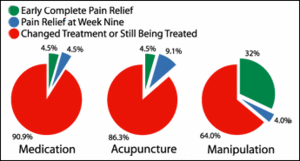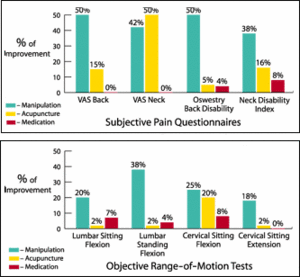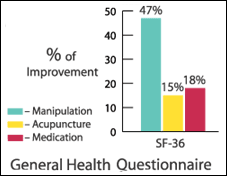Chiropractic Best for Chronic Spine Pain
New Research Shows Manipulation Superior to Acupuncture, Drugs
By Editorial Staff
A randomized, controlled clinical trial just published in Spine1 reveals that chiropractic “manipulation” is superior to both drugs and acupuncture in the treatment of chronic spinal pain (people with pain lasting more than 13 weeks). The study, conducted at a multidisciplinary spinal pain outpatient unit (MSPU) in an Australian public hospital, involved 115 patients randomly assigned to receive one of three interventions: medication, needle acupuncture or chiropractic manipulation.
Patients randomized to the acupuncture or spinal manipulation group were given an initial physical examination by the treating clinician to determine which form of acupuncture needle placement and needling would take place, or what type of spinal manipulation would be performed, respectively. Patients randomized to the medication group were given Celebrex, unless the patient had used it previously. The next drug of choice was Vioxx, followed by paracetamol (up to 4g/day). Doses were left to the sports physician’s discretion.
Chiropractors administered “high-velocity, low-amplitude” manipulations. Chiropractic patients were given two treatments per week.
The patients were assessed four times: at the initial visit, and two, five and nine weeks after the initial treatment. The Oswestry Questionnaire for low back and thoracic spine pain (“back” pain), the Neck Disability Index (NDI) for neck pain, and the Short-Form-36 Health Survey questionnaire (SF-36) were self-administered. Visual analog scales (VAS) were used to assess subjective pain intensity.
Objective measurements included straight-leg raising, recorded using a protractor with a plumb-bob to measure the angle. Lumbar spine ranges of movement also were measured using a calibrated Perspex device; cervical spine ranges of movement were measured using a cervical range-of-motion instrument (CROM).
While a number of patients didn’t finish the study, due to noncompliance or treatment changes, the statistical significance of the results was maintained for most outcomes. At the end of the study, the group receiving manipulation experienced the most recovered patients (9) compared with three for the acupuncture group and only two for the medication group. This was significant, considering the nature of chronic spine pain.
Patient assessments for the three groups also indicated superiority for chiropractic manipulation for all tests except the VAS for neck pain. This superiority is demonstrated in the percentage of improvement that patients in each of the three groups experienced as measured by the assessment tools (see charts above).
One of the study’s most remarkable findings was that patients in the manipulation group reported a 47 percent improvement on the SF-36 questionnaire, compared to only 15 percent for the acupuncture group and 18 percent for the medication group. This finding is all the more significant because the SF-36 does not measure back pain per se, but gives a perception of the level of one’s overall health.
In addition to these results, the authors included the following comments in their report:
“The results of this efficacy study suggest that spinal manipulation, if not contraindicated, may be superior to needle acupuncture or medication for the successful treatment of patients with chronic spinal pain syndrome, except for those with neck pain. The NDI showed that for neck pain, acupuncture achieved a better result than manipulation.
“Considering that the patients in this study had experienced chronic spinal pain syndrome for an average of 4.5 years in the medication group, 6.4 years in the acupuncture group, and 8.3 years in the spinal manipulation group, it is notable that manipulation, during a maximum treatment duration of nine weeks, achieved asymptomatic status for every fourth patient (27%). This result is superior to the percentages for acupuncture (9.4%) and medication (5%) for short-term outcomes. …
“Medication apparently did not achieve a marked improvement in chronic spinal pain and caused adverse reactions in 6.1% of the patients. The adverse symptoms disappeared once medication was stopped. …
“The results of this study can be generalized because the study sample had a broad socioeconomic background and a wide age range. …
“In summary, the significance of the study is that for chronic spinal pain syndromes, it appears that spinal manipulation provided the best overall short-term results, despite the fact that the spinal manipulation group had experienced the longest pretreatment duration of pain.”
Reference
- Giles LGF, Muller R. Chronic spinal pain – a randomized clinical trial comparing medication, acupuncture, and spinal manipulation. Spine 2003;28:1490-1503.


